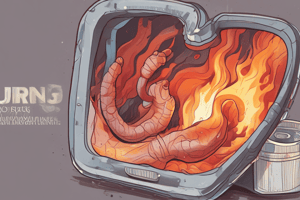Podcast
Questions and Answers
What is the primary cause of pain in burns?
What is the primary cause of pain in burns?
- Nerve damage
- Inflammation (correct)
- Charring of the skin
- Damage to the epidermis
Which of the following types of burns is characterized by charring and blackening?
Which of the following types of burns is characterized by charring and blackening?
- First-degree burns
- Second-degree burns
- Third-degree burns (correct)
- Fourth-degree burns
What is the primary goal of first aid in treating burns?
What is the primary goal of first aid in treating burns?
- Managing pain
- Applying a non-stick dressing
- Removing dead tissue
- Stopping the burning process (correct)
What is the most common complication of burns?
What is the most common complication of burns?
What type of burn is caused by electrical current?
What type of burn is caused by electrical current?
What is the purpose of debridement in treating burns?
What is the purpose of debridement in treating burns?
Flashcards are hidden until you start studying
Study Notes
Classification of Burns
- First-degree burns: affect only the epidermis (outermost layer of skin), causing redness, swelling, and pain
- Second-degree burns: affect both the epidermis and dermis (layer beneath the epidermis), causing blisters, redness, swelling, and pain
- Third-degree burns: affect all layers of skin, causing charring, blackening, and potentially numbness due to nerve damage
- Fourth-degree burns: extend beyond the skin to affect muscles, bones, and organs
Causes of Burns and Scalds
- Thermal burns: caused by heat from fire, flames, or hot objects
- Scalds: caused by hot liquids or steam
- Electrical burns: caused by electrical current
- Chemical burns: caused by strong acids or bases
Signs and Symptoms
- Pain: severity depends on the degree of burn
- Redness and swelling: due to inflammation
- Blisters: characteristic of second-degree burns
- Charring or blackening: characteristic of third-degree burns
- Numbness: due to nerve damage in third-degree burns
- Difficulty breathing: if burns affect the face or airway
Treatment and Management
- First aid: stop the burning process, cool the burn with cool water, remove clothing and jewelry, and apply a non-stick dressing
- Wound care: clean and dress the wound regularly to prevent infection
- Pain management: use analgesics and other medications to manage pain
- Debridement: removal of dead tissue to promote healing
- Surgical intervention: may be necessary for severe burns or to repair damaged tissues
Complications
- Infection: most common complication of burns
- Scarring: may lead to permanent disfigurement
- Hypovolemic shock: due to fluid loss
- Respiratory distress: if burns affect the face or airway
- Long-term psychological trauma: may occur in severe cases
Studying That Suits You
Use AI to generate personalized quizzes and flashcards to suit your learning preferences.




